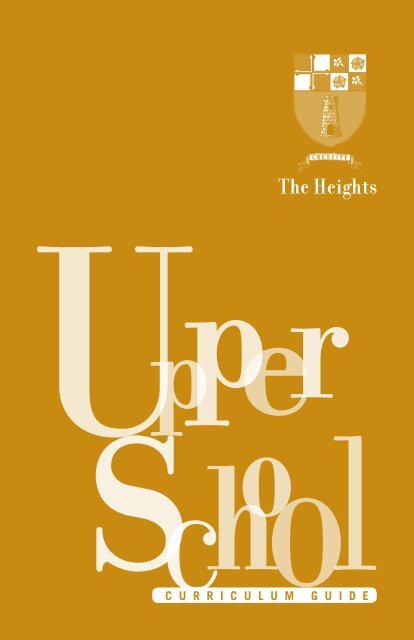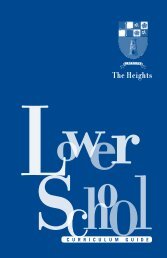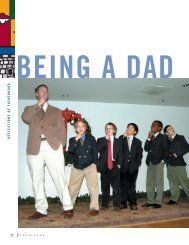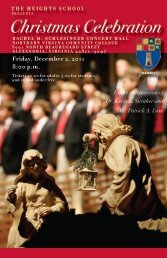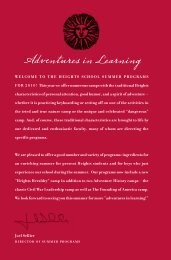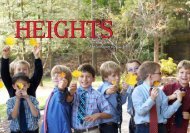The Heights School
The Heights School
The Heights School
Create successful ePaper yourself
Turn your PDF publications into a flip-book with our unique Google optimized e-Paper software.
<strong>The</strong> <strong>Heights</strong><br />
Uppr e<br />
Sh o l<br />
cC u r r i c u l u m G u i d e<br />
0
Contents<br />
I. Academics at <strong>The</strong> <strong>Heights</strong>: An Overview<br />
Crescite 2<br />
Why <strong>Heights</strong> Students Study the Liberal Arts 3<br />
<strong>The</strong> Vision of the World Taught at <strong>The</strong> <strong>Heights</strong> 3<br />
<strong>Heights</strong> Education Imparts Knowledge with Training in Virtues 4<br />
True Friendship between Teacher and Student is Fostered 5<br />
Parents as Primary Educators 6<br />
II. <strong>The</strong> Upper <strong>School</strong> Academic Program<br />
A Solid Liberal Arts Curriculum 7<br />
Tailored to Each Student’s Abilities and Interests 8<br />
Graduation Requirements 8<br />
Grading, Report Cards and Transcripts 9<br />
III. Courses by Department<br />
English 10<br />
Mathematics 12<br />
Classics 13<br />
History 14<br />
Religion 15<br />
Science 16<br />
Spanish 17<br />
Art 18<br />
Computers 18<br />
Music 19
I.<br />
Academics at <strong>The</strong> <strong>Heights</strong>:<br />
An Overview<br />
Crescite<br />
<strong>The</strong> <strong>Heights</strong> <strong>School</strong> provides a traditional liberal arts curriculum grounded in<br />
the western canon, the body of learning on which western civilization rests. By<br />
incorporating the many noble aspirations and developments of the modern world<br />
into this classical context, <strong>The</strong> <strong>Heights</strong> <strong>School</strong> strives to achieve the goal of the<br />
full human development of each student. <strong>The</strong> school motto, Crescite, is the Latin<br />
translation of the Creator’s first words to man, increase and grow. Indeed that<br />
divine command is the foundation of the <strong>Heights</strong> mission: to assist parents in the<br />
intellectual, moral, physical, and spiritual education of their sons.<br />
A liberal arts curriculum is essential to this mission. <strong>The</strong> liberal arts have<br />
been traditionally grouped into two broad disciplines: the trivium, consisting of<br />
grammar, logic, and rhetoric and the quadrivium, consisting of astronomy, music,<br />
geometry, and arithmetic. At the <strong>Heights</strong>, these disciplines are represented by a<br />
core of courses in ten academic departments: English, Mathematics, Classics,<br />
History, Religion, Science, Spanish, Art, Computers, and Music.<br />
Why <strong>Heights</strong> Students Study the Liberal Arts<br />
<strong>The</strong> primary focus of a liberal arts education is the development of true freedom<br />
that will enable one to live a more complete human life, as opposed to the mere<br />
attainment of some technical skills or knowledge. <strong>The</strong> root of the word “liberal”<br />
is the Latin word liber, meaning “free.” A liberal arts education increases one’s<br />
freedom, understood as the ability to embrace the Good, wherever it is truly<br />
recognized. It imparts the freedom necessary to join with the great minds of<br />
history, rising above one’s current situation and culture, to appreciate what is<br />
deepest in our human condition: the meaning of love, suffering, sacrifice, death,<br />
and generous service to others. Acquiring a liberal education is a life-long process;<br />
<strong>The</strong> <strong>Heights</strong> <strong>School</strong> strives to form life-long learners who have what educator and<br />
philosopher John Henry Cardinal Newman called a “habit of mind” in pursuit of<br />
intellectual excellence and the contemplative life.<br />
Liberal arts teach, among other things, a respect for the proper and responsible<br />
use of words, the sincere asking of questions, the recognition and appreciation of<br />
the Good, the True, and the Beautiful. A liberal arts education also opens the door<br />
to many professional opportunities. <strong>The</strong> fruits of a liberal arts education – a broad<br />
understanding of reality, clarity in thought, excellence in writing, and effective<br />
speaking skills – are very important in many professions, especially for those in<br />
positions of leadership.<br />
<strong>The</strong> Vision of the World Taught at <strong>The</strong> <strong>Heights</strong><br />
<strong>The</strong> curriculum of <strong>The</strong> <strong>Heights</strong> <strong>School</strong> is rooted in a perspective that sees the<br />
abundant goodness of the world, of all creation, as a fundamental governing<br />
principle. In the words of Saint Josemaria Escriva, “<strong>The</strong> world is not evil, because<br />
it comes from the hands of God, because it is His creation, because Yahweh looked<br />
upon it and saw that it was good. It is we ourselves, men and women, who make<br />
it evil and ugly with our sins and unfaithfulness.” This truth naturally leads us to<br />
study, to reflect upon and to contemplate all the human riches of our past and the<br />
world of today as ways to discover God in the ordinary things, to know and “serve<br />
Him in and from the ordinary, secular, and civil activities of human life.” <strong>The</strong><br />
<strong>Heights</strong> will thus refrain from narrowly embracing one ideology, political agenda,<br />
2 T h e H e i g h t s S c h o o l U p p e r S c h o o l C u r r i c u l u m G u i d e 3
philosophical school or approach to the rich drama of human history and thought.<br />
Grounded in the western tradition, a <strong>Heights</strong> education values the abundant<br />
goodness of the world as created by God and sees the nobility and heroism in<br />
struggles of individuals, both men and women, throughout history.<br />
<strong>Heights</strong> Education<br />
Imparts Knowledge with Training in Virtues<br />
Education is much more than the delivery of a curriculum, however outstanding<br />
such a curriculum may be. Authentic education involves a forming of the mind<br />
and heart so that students and teachers embrace the riches of a liberal arts<br />
curriculum, constantly striving to delve into these riches. A strong part of the school<br />
culture is a recognition that focused, serious study is an important professional<br />
obligation for students. Indeed, the sense of schoolwork as the beginning of one’s<br />
professional life and thus an important means of serving others informs the way<br />
study is viewed in the <strong>Heights</strong> community. Furthermore, the relationship between<br />
<strong>The</strong> <strong>Heights</strong> <strong>School</strong> and Opus Dei helps to foster the sense that doing even the<br />
most ordinary things, like studying, extraordinarily well for a noble motive enables<br />
us to offer our best to God and so draw close to Him.<br />
Concentrated study, especially in our fast-paced, entertainment-driven culture,<br />
requires practice in building up one’s ability to focus, memorize, analyze and<br />
contemplate with a sense of wonder. Students need to foster the strenuous silence<br />
of living at a slower, more contemplative pace – to be comfortable with the pace<br />
of a page turning. Living an intellectual life today requires a certain amount of<br />
asceticism. Students need to limit time spent in front of television or computer<br />
screens, with their fast-paced barrage of images, and spend time every day in real<br />
study in an environment free from distractions. Fortitude and temperance lead to<br />
a well-ordered soul, one that is capable of living a studious life. But this strength<br />
of mind must also be accompanied by real wisdom of the heart – the appropriate<br />
fostering of the imagination and intuition so that the heart is attuned with the<br />
attractiveness of the goodness of reality. Intellectual virtue is perfected when it<br />
leads to true contemplation.<br />
True Friendship<br />
between Teacher and Student is Fostered<br />
<strong>The</strong> <strong>Heights</strong> faculty strives to foster an environment that focuses on friendship<br />
and cheerfulness as essential to the education process. Friendship involves<br />
being concerned for the good of the other. It often begins through sharing similar<br />
interests. Friendships among students are necessary for emotional stability and<br />
genuine human development. <strong>The</strong> <strong>Heights</strong> faculty works to create an environment<br />
where these friendships can naturally develop. <strong>The</strong> faculty member also, in a<br />
manner consistent with the proper teacher-student relationship, seeks to be a<br />
friend to his students. This means striving to convey what is objectively necessary<br />
for full human development.<br />
Teaching is not simply the passing on of information but of a vision of life rooted in<br />
a noble understanding of human nature. <strong>The</strong> teacher readily exposes the rationale<br />
behind the material to his students and seeks to help his students relate what<br />
they know already to further knowledge. <strong>The</strong> personal relationship between teacher<br />
and student is rooted in an understanding of the students as fundamentally free<br />
to embrace truth and take ownership of the great intellectual heritage that is our<br />
common inheritance. <strong>The</strong> teacher serves the dynamic process of passing on this<br />
great treasure to yet one more generation. <strong>The</strong> freedom necessary for this process<br />
must be respected and fostered by allowing appropriate expressions of personality<br />
in the classroom. A cheerful tone provides the optimum environment for such<br />
development. A <strong>Heights</strong> teacher will thus never be an authoritarian figure but<br />
will rather exercise his legitimate authority through the personal relationships he<br />
establishes through his teaching.<br />
4 T h e H e i g h t s S c h o o l U p p e r S c h o o l C u r r i c u l u m G u i d e 5
Parents as Primary Educators<br />
<strong>The</strong> reality that parents are in fact the primary educators of their children informs<br />
the entire educational philosophy at <strong>The</strong> <strong>Heights</strong> <strong>School</strong>. Not only are parents the first<br />
teachers of their children but, through establishing a home with its specific culture,<br />
they continue to form a grounding from which a growing boy learns to assimilate and<br />
value the education and formation available at school. It is absurd to think that any<br />
school, even the best possible school, can take on the task of passing on the riches<br />
of a liberal arts education in only the time a student is at school, about seven hours<br />
per day for roughly half the calendar days of a year. A liberal arts education must be<br />
supported by good habits of reading, conversation, and study; and these are fostered<br />
in the home. To any impartial observer of our culture it is easy to see that one of its<br />
defining characteristics is entertainment. We live in an entertainment culture. <strong>The</strong> most<br />
common forms of entertainment, especially for our children, are video games, television,<br />
movies, certain types of music, and aspects of the Internet. All of these mediums<br />
have contributed to a faster, less contemplative pace. <strong>The</strong> fast-paced nature of these<br />
entertainment media makes focused study and contemplation difficult.<br />
<strong>The</strong> <strong>Heights</strong> <strong>School</strong> relies on parents who are fully-activated primary educators to<br />
establish a home environment that is in unison with the formative and educative<br />
mission of the <strong>School</strong>. <strong>The</strong> faculty members of <strong>The</strong> <strong>Heights</strong> are under no illusion that it<br />
is possible to accomplish our noble goal without the active support of parents in this<br />
area. When parents establish a home where each child is truly valued as a person and<br />
the personal relationships between the members of the family have precedence over<br />
material things and entertainment, they are establishing the necessary conditions<br />
that make acquiring a liberal arts education possible. Parents who are fully activated<br />
primary educators will foster a variety of worthwhile cultural endeavors, such as<br />
reading and discussing good literature, taking family excursions, and living family<br />
traditions in the home. <strong>The</strong>se good endeavors will only grow through the example and<br />
encouragement of parents and the prudent limiting of modern forms of entertainment<br />
that otherwise would tend to take the place of reading and other cultural pursuits.<br />
For this reason, <strong>The</strong> <strong>Heights</strong> <strong>School</strong> seeks to enter into a partnership with families to<br />
work together to accomplish this mission. In the <strong>School</strong>’s admission process, through<br />
the family interview and in other ways, the <strong>School</strong> actively seeks boys whose parents<br />
share this vision and strive to put it into practice.<br />
II.<br />
<strong>The</strong> Upper <strong>School</strong><br />
Academic Program<br />
A Solid Liberal Arts Curriculum<br />
Tailored to Each Student’s Abilities and Interests<br />
Keeping in mind the medieval saying, “Everything is received according to the<br />
mode of the receiver,” the academic programs for <strong>Heights</strong> students often differ<br />
significantly based on each student’s abilities and interests. While the core<br />
curriculum is strong and includes several required courses, there is considerable<br />
flexibility among certain core requirements and among elective choices. <strong>The</strong> overall<br />
academic program is ideal for students of above average to truly exceptional ability.<br />
Each student meets personally with the Head of the Upper <strong>School</strong> every year,<br />
often more than once, to work out an academic schedule for the upcoming year.<br />
Students are encouraged to discuss options with their parents and sometimes<br />
parents also join students in meeting to discuss scheduling options. All academic<br />
programs are given final approval by the Head of the Upper <strong>School</strong> and sometimes<br />
approved changes are made after the school year begins. A good schedule is one<br />
that follows the core requirements outlined below, engages areas of academic<br />
interest, and provides the appropriate level of challenge. While the spirit of study<br />
intensifies in the classroom, a good schedule will require a consistent average<br />
of two to three hours of focused study outside of regular school hours each day.<br />
<strong>The</strong> amount of flexibility in the academic program increases in the junior and<br />
senior years. Options to pursue some studies in a more focused discipline<br />
increase. Options include advanced language classes, several AP courses, more<br />
flexibility in selecting history courses, computer programming courses, and other<br />
elective classes.<br />
6 T h e H e i g h t s S c h o o l U p p e r S c h o o l C u r r i c u l u m G u i d e 7
Graduation requirements<br />
n English<br />
4 years<br />
n Mathematics<br />
4 years<br />
n History<br />
4 years<br />
n Science<br />
3 years<br />
(Includes 1 year of biology and 1 year of chemistry)<br />
n Foreign Language 3 years<br />
n Second Foreign Language 6 years<br />
Grading, report cards, and transcripts<br />
While grades for each quarter, the mid-year exam, and the final exam show up on<br />
a student’s report card, only the final course grade or current average is shown<br />
on the transcript that is sent to colleges. A student’s final grade in a course is<br />
determined by averaging the two semester grades with each semester grade being<br />
the weighted average of the two quarters counting 37.5% each and the exam<br />
(either mid-year or final) counting 25.0%.<br />
GPAs are given separately for each academic year and a cumulative GPA is given<br />
at the bottom of the transcript. In calculating these GPAs a standard 4.0 scale is<br />
followed:<br />
Electives<br />
n Religion or Ethics<br />
n Athletics<br />
4 years<br />
(Religion is required for Catholic students; non-<br />
Catholic students may choose either religion or ethics)<br />
4 years<br />
(Students are required to participate in at least one<br />
varsity, junior varsity, or intramural sport per year.)<br />
A+ 4.0 B+ 3.3 C+ 2.3 D+ 1.3 F 0.0<br />
A 4.0 B 3.0 C 2.0 D 1.0<br />
A- 3.7 B- 2.7 C- 1.7 D- 0.7<br />
<strong>The</strong> <strong>Heights</strong> <strong>School</strong> does not weight its GPA.<br />
Students who successfully complete Algebra II H, Latin II, or Spanish II (usually in<br />
their freshman year) will automatically earn credit for Algebra I, Latin I, or Spanish<br />
I, respectively. <strong>The</strong>se credits will not impact a student’s grade point average (GPA).<br />
With the approval of the Head of the Upper <strong>School</strong>, a student may take a course at<br />
another institution for credit. <strong>The</strong> <strong>Heights</strong> can note on the transcript that a course<br />
has been taken elsewhere, and that credit has been received. This course, however,<br />
will not be factored into the student’s grade point average for <strong>The</strong> <strong>Heights</strong> <strong>School</strong>.<br />
<strong>The</strong> Head of the Upper <strong>School</strong> can, with good reason, modify the above requirements<br />
for particular situations. Any student who successfully completes four years of an<br />
approved academic program can assume he has met all necessary graduation<br />
requirements unless he specifically is informed otherwise.<br />
8 T h e H e i g h t s S c h o o l U p p e r S c h o o l C u r r i c u l u m G u i d e 9
III.<br />
Courses by Department<br />
English<br />
<strong>Heights</strong> English teachers share a common love for the beauty of the written word<br />
and appreciation for the wisdom, moral vision, and truth that it can convey.<br />
Each class focuses on delving into the riches of the literary tradition of western<br />
civilization and helping students master the skills necessary to appreciate<br />
literature. Each grade has its standard literary works that do not change from<br />
year to year along with a few options for the teacher to introduce works he deems<br />
beneficial. <strong>The</strong> dynamic literary culture of <strong>The</strong> <strong>Heights</strong> <strong>School</strong> overflows on festival<br />
clan days and through several popular extracurricular opportunities, such as<br />
reading and discussion groups and other literary societies.<br />
Substantial work is also done on improving each student’s writing. New upper<br />
school students are issued copies of the text English Simplified. This text briefly<br />
presents grammatical and stylistic guidelines for writing that are followed for all<br />
upper school classes.<br />
C o u r s e o f f e r i n g :<br />
n English I (9th grade): Chivalry in Literature—Students study classic works,<br />
several from or related to the medieval period: Sir Gawain and the Green Knight,<br />
Shakespeare’s Henry V, Beowulf and <strong>The</strong> Aeneid. <strong>The</strong>re is continuing work in<br />
grammar and vocabulary and a strong focus on improving writing skills.<br />
n English II (10th grade): Conscience and the Consciousness of Evil—<strong>The</strong> 10th<br />
grade English course continues to review grammar and helps students improve<br />
their writing skills and vocabularies. Texts include Lord of the Flies, Macbeth,<br />
Othello, A Man for All Seasons, Picture of Dorian Gray and <strong>The</strong> Odyssey.<br />
n English III (11th Grade):: Mortality and Immortality—This junior course<br />
continues to foster the development of superior grammar and writing skills.<br />
Students delve into a rich selection of literature including Moby Dick, Njal’s<br />
Saga, <strong>The</strong> Inferno and King Lear.<br />
n English IV (AP English Literature—12th Grade): Coming of Age: Claiming<br />
Adulthood—This senior course caps an outstanding program with an in-depth<br />
treatment of a variety of literary forms: novels, short stories, plays and poetry.<br />
Students read Oedipus Rex and Antigones by Sophocles, A Midsummer Night’s<br />
Dream and Hamlet by Shakespeare and <strong>The</strong> Remains of the Day by Kazuo<br />
Ishiguro. Students work on fine-tuning their writing skills on the collegiate level.<br />
Most students will take the AP Literature exam at the end of the course.<br />
10 T h e H e i g h t s S c h o o l U p p e r S c h o o l C u r r i c u l u m G u i d e 11
Mathematics<br />
Math is important for all students, not merely for those who aspire to a profession<br />
that will require its use. Indeed, the primary reason for studying math is its proven<br />
role in a liberal arts education, not its utility. Math helps students develop into<br />
clear and logical thinkers and to recognize systemic and dynamic relationships<br />
in the world. <strong>The</strong>se relationships are closely connected to the order and beauty in<br />
creation. Typically, studies in math are a student’s first introduction to abstract<br />
thought. This prepares students well for the rigors of later studies in philosophy.<br />
<strong>The</strong> famous inscription above Plato’s academy recalls this relationship between<br />
math and philosophy, “If you do not know geometry, you cannot enter here.”<br />
<strong>The</strong> math curriculum at <strong>The</strong> <strong>Heights</strong> <strong>School</strong> is strongly influenced by the Saxon<br />
textbooks series. <strong>The</strong> Saxon program helps students master the math by doing<br />
a carefully designed series of cumulative problem sets. Even in classes that use<br />
texts other than Saxon, the focus of the course is on mastery demonstrated by the<br />
successful completion of math problems.<br />
C o u r s e o f f e r i n g s :<br />
n Algebra I: This course is offered for 9th grade students who need one more year<br />
to master the concepts in Algebra I before moving on to higher math.<br />
n Algebra II: Many freshmen take this course on the honors level.<br />
n Geometry (honors and standard)<br />
n Pre-Calculus (honors and standard)<br />
n Calculus H<br />
n Calculus I: AP AB<br />
Classics<br />
<strong>The</strong> Classics Department at <strong>The</strong> <strong>Heights</strong> <strong>School</strong> seeks to further the human and<br />
intellectual development of each boy through the discipline of learning Latin and<br />
Greek and through contact with the riches of classical culture. This department<br />
has always been and will always remain a fundamental part of the education<br />
offered at <strong>The</strong> <strong>Heights</strong> <strong>School</strong>.<br />
Many students entering the Upper <strong>School</strong> from the Middle <strong>School</strong> have already<br />
mastered the basics of the Latin language. Regardless of previous studies,<br />
all Upper <strong>School</strong> students are required to take at least two years of Latin. <strong>The</strong><br />
curriculum ends with advanced courses offered on Vergil and Lucretius.<br />
Greek may be taken as early as the freshman year in the Upper <strong>School</strong>. Again,<br />
the student is first drilled in grammar and basic vocabulary, then introduced to<br />
original texts. It is necessary to study two years of Latin before taking Greek.<br />
<strong>The</strong> classical languages are seen as the key to the academic curriculum because<br />
of their connection pedagogically and linguistically to the liberal arts. <strong>The</strong> mastery<br />
of English is greatly facilitated by the study of Latin and Greek. Students are<br />
forced to know the meaning of words and their syntactical use in a sentence.<br />
Reflecting the nature of their respective cultures, the classical languages instill<br />
Roman discipline, simplicity and clarity and Greek subtlety and harmony into the<br />
mental habits of the boys. <strong>The</strong> classical languages are fixed and clear, naturally<br />
leading to superior habits of thought. Finally, they are the conduit of classical<br />
culture. <strong>The</strong>y are the “mother tongues” of the western canon, the possession of<br />
every educated man throughout western history. <strong>The</strong>y enable the student to speak<br />
with the great minds of history on an equal footing.<br />
C o u r s e o f f e r i n g s :<br />
n Calculus II: AP BC<br />
n Latin I<br />
n Latin: Vergil AP<br />
n Greek III Honors<br />
n Calculus III: Differential Equations / Multi-Variable Calculus — This course is<br />
n Latin II<br />
n Latin Seminar: Lucretius<br />
n Greek IV Honors<br />
offered on a need basis for extremely advanced students.<br />
n Latin Language Honors<br />
n Greek I Honors<br />
n AP Statistics: This is an elective math course that is open to juniors and seniors.<br />
n Latin Literature Honors<br />
n Greek II Honors<br />
12 T h e H e i g h t s S c h o o l U p p e r S c h o o l C u r r i c u l u m G u i d e 13
History<br />
<strong>The</strong> History Department at <strong>The</strong> <strong>Heights</strong> <strong>School</strong> offers courses that help students<br />
understand the riches of the past. <strong>The</strong> focus is primarily on the western tradition,<br />
though not exclusively. Each teacher helps his students to understand and<br />
appreciate the common heritage of our past and to improve in research and writing<br />
skills. <strong>The</strong> focus is on history as a narrative story that cannot be explained away by<br />
any one perspective, whether economic or political. <strong>The</strong> course of history is strongly<br />
influenced by individuals exercising their freedom, for heroic ends or otherwise.<br />
<strong>The</strong> 9th grade standard course begins where the 8th grade ancient history class<br />
ended, around 500 A.D. Thus all students are exposed to ancient and modern<br />
European (and some world) history and a full year of US History and Government<br />
during grades 8 through 10. Juniors and seniors are required to choose at least<br />
one history elective per year. In addition, each student is required to pass either<br />
AP US History or AP Modern European History to graduate.<br />
C o u r s e o f f e r i n g s :<br />
n Medieval and Renaissance History (9th grade)<br />
n United States History and Government (10th grade)<br />
n AP US History (elective)<br />
n AP US Government (elective)<br />
n AP Modern European History (elective)<br />
n World War II / Cold War (elective)<br />
n AP Economics, both microeconomics and macroeconomics offered on<br />
alternating years (electives)<br />
n AP Art History (elective)<br />
Religion<br />
<strong>The</strong> Religion Department at <strong>The</strong> <strong>Heights</strong> <strong>School</strong> provides a full program of Catholic<br />
practice and doctrine for Catholic students (and non-Catholics who freely choose<br />
to participate) at every grade level. In addition, an Ethics program is available<br />
for non-Catholic students in grades 9 through 12. All religion teachers at <strong>The</strong><br />
<strong>Heights</strong> <strong>School</strong> strive to provide solid doctrinal formation in full agreement with<br />
the Catechism of the Catholic Church and magisterial teachings. In addition, the<br />
Religion Department teaches basic prayers and sacramental practices.<br />
In accord with the teachings of the Second Vatican Council and the spirit of Opus<br />
Dei, the Religion Department at <strong>The</strong> <strong>Heights</strong> <strong>School</strong> places emphasis on the reality<br />
that all men and women are called to holiness. This focus on the universal call<br />
to holiness and apostolate in the Church is rooted in a keen awareness of one’s<br />
divine filiation, the realization that we are all children of God.<br />
C o u r s e o f f e r i n g s :<br />
n Overview of Catholicism (9th grade)<br />
n Church History (10th grade)<br />
n Christian Moral Life (11th grade)<br />
n Apologetics (12th grade)<br />
n Ethics I<br />
n Ethics II<br />
n Ethics III<br />
n Ethics IV<br />
n Philosophy and Logic (elective)<br />
n American Foreign Policy (elective)<br />
n Russian History (elective)<br />
14 T h e H e i g h t s S c h o o l U p p e r S c h o o l C u r r i c u l u m G u i d e 15
Science<br />
<strong>The</strong> science program at <strong>The</strong> <strong>Heights</strong> <strong>School</strong> contributes to a liberal arts education<br />
by helping students understand the world around them. Careful observations and<br />
thoughtful analysis lead to a sense of wonder at the complexity and order both in nature<br />
and in the artifices of man. <strong>The</strong> <strong>Heights</strong> science program lays a good foundation for<br />
students interested in science, medicine or engineering as possible careers. All students<br />
are required to pass biology, chemistry and one other elective science.<br />
C o u r s e o f f e r i n g s :<br />
n Biology (9th grade)<br />
n Chemistry (10th grade)<br />
n Environmental Science (elective)<br />
n Anatomy and Physiology (elective)<br />
n AP Biology (elective)<br />
n AP Chemistry (elective)<br />
Spanish<br />
<strong>The</strong> Spanish Department at <strong>The</strong> <strong>Heights</strong> <strong>School</strong> offers a variety of Spanish classes<br />
for students in grades 7 through 12. All Spanish teachers seek to teach the<br />
technical aspects of the Spanish language as well as conversational Spanish and<br />
cultural information. Students with ability and interest may take AP courses in<br />
Spanish Language (usually in grade 11) and Spanish Literature (usually in grade<br />
12). Learning Spanish further reinforces knowledge of grammatical structures<br />
taught in Latin and English classes.<br />
C o u r s e o f f e r i n g s :<br />
n Spanish I<br />
n Spanish II<br />
n Spanish III Honors<br />
n Spanish Language AP<br />
n Spanish Literature AP<br />
n AP Physics (elective)<br />
16 T h e H e i g h t s S c h o o l U p p e r S c h o o l C u r r i c u l u m G u i d e 17
Art<br />
<strong>The</strong> Art Department at <strong>The</strong> <strong>Heights</strong> <strong>School</strong> follows a classical approach to art,<br />
stressing that art should be based in reality and beauty. Students learn the<br />
discipline of drawing using perspective and using color appropriately. Several<br />
students excel and develop their natural talents. Carpentry and AP Art History meet<br />
daily for a full credit.<br />
C o u r s e o f f e r i n g s<br />
n Art<br />
n Art II<br />
n Carpentry and Practical Building Skills<br />
n AP Art History<br />
Computers<br />
<strong>The</strong> <strong>Heights</strong> <strong>School</strong> offers two levels of computer programming, Computers I and<br />
Computers II AP. <strong>The</strong>se elective classes are open to juniors and seniors who are<br />
interested in learning about computer programming. Computer programming<br />
helps the boys to think analytically and reinforces the benefits of math classes.<br />
In addition, the Internet is available in the library for students to use in a closelymonitored<br />
environment. <strong>The</strong> <strong>Heights</strong> <strong>School</strong> has refrained from relying too heavily<br />
on computers in education, especially in the lower grades. While computers can<br />
certainly be a very useful tool, the key academic struggles that young students<br />
face relate not so much to accessing information in an efficient manner as to<br />
processing and synthesizing the information that is available to them from so<br />
many sources. A liberal arts education must first help students to learn how to be<br />
critical readers, thinkers and writers.<br />
Music<br />
As one of the four subjects in the quadrivium, music is integral to a liberal arts<br />
education. In order to truly be well educated, a man must achieve an integration<br />
of his passions with his reason. Music educates the passions and, when done<br />
properly, helps one to place them at the service of right reason. Education in<br />
music works on many levels, helping to spur intellectual and moral development<br />
in a manner that complements other academic subjects.<br />
Students in the Upper <strong>School</strong> have the option of choosing a cappella singing as<br />
an elective class. <strong>The</strong> a cappella program has grown to approximately 60 Upper<br />
<strong>School</strong> students who perform admirably in competitions and at several school<br />
functions, including the Christmas concerts and solemn Masses.<br />
In addition, the Music Department offers formal classes in Music History and<br />
AP Music <strong>The</strong>ory on alternating years. <strong>The</strong>re are also band programs in which<br />
several Upper <strong>School</strong> students participate. Each music course counts for a full<br />
credit except band, which counts for half of a credit.<br />
C o u r s e o f f e r i n g s :<br />
n A cappella I<br />
n A cappella II<br />
n A cappella III<br />
n A cappella IV<br />
n Band (1/2 credit)<br />
C o u r s e o f f e r i n g s :<br />
n Computers I<br />
n Computers II<br />
18 T h e H e i g h t s S c h o o l U p p e r S c h o o l C u r r i c u l u m G u i d e 19
Mission Statement<br />
<strong>The</strong> <strong>Heights</strong> <strong>School</strong> is a private, independent, preparatory school for boys, grades<br />
three to twelve. <strong>The</strong> <strong>School</strong> assists parents in the intellectual, moral, physical, and<br />
spiritual education of their sons. Dedicated teachers impart rigorous academic<br />
training in all the major areas of the liberal arts. Formation in virtue fosters<br />
respect for every person, a desire to serve God and others, and an optimistic<br />
attitude towards life’s challenges. <strong>The</strong> <strong>School</strong>’s Christian orientation and spiritual<br />
formation are entrusted to Opus Dei, a Personal Prelature of the Catholic Church.<br />
20 T h e H e i g h t s S c h o o l
<strong>The</strong> <strong>Heights</strong> <strong>School</strong><br />
10400 Seven Locks Road<br />
Potomac, Maryland 20854<br />
t: 301.365.4300<br />
f: 301.365.4303<br />
www.heights.edu


